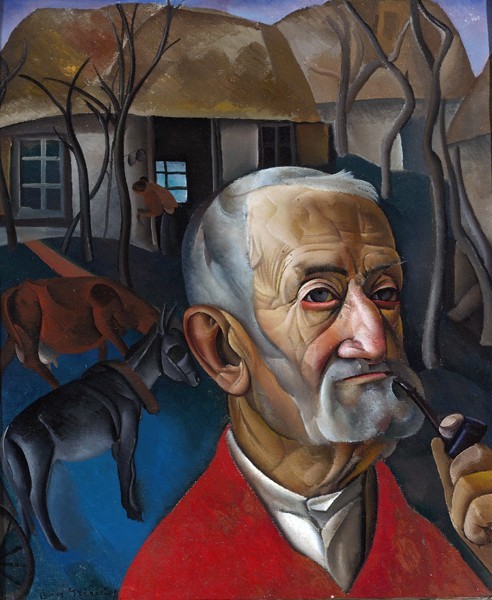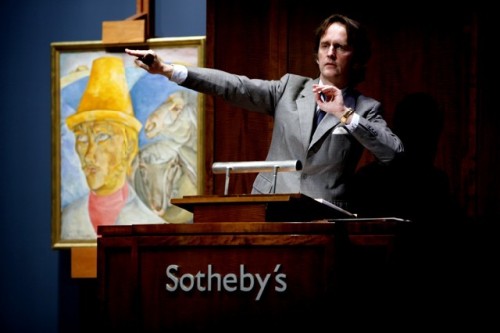Stuart Chase Resigns Abruptly from Berkshire Museum
Push Comes to Shove in Board Conflict
By: Charles Giuliano - Feb 15, 2011
A day late and a dollar short the press release, which we had to request, arrived announcing that Stuart Chase has resigned as director of the Berkshire Museum in Pittsfield. The boiler plate announcement appears below.
It reveals not a clue as to what prompted the abrupt resignation of a popular museum director, who just loved the job, and was in the final phases of a $10.3 million renovation of an eclectic institution and its mongrel collections.
On many levels the Berkshire Museum with its combination of fine arts, bric a brac, plaster casts left over from the 19th century, natural history and an aquarium required a very broad and gifted director to embrace and flourish with such daunting diversity.
For all of those reasons, Chase, an art historian and nature lover, appeared to be the perfect match. During a winter of record snow, while most of us grumble about shoveling and poor driving, Chase, with typical gusto has been shushing down the slopes.
Although the Berkshire Museum made great strides with Chase there are many challenges for arts organizations. The issue of conflict with the Board appears to be how best to handle an asset that Chase unearthed and developed brilliantly.
There was also a windfall resulting from the deaccession of three paintings by the Russian artist Boris Dimitrievich Grigoriev (1886-1939). They sold for $7 million at Sotheby's on November 3, 2008. The funds applied to the newly created Florence Keep and Josephine Crane Fund honoring the original donors of the paintings.
By the guidelines of the Association of American Museums (AAM), of which the Berkshire Museum is a member, when works are sold from collections the funds may only be used for acquiring new works. It is strictly against the AAM rules, as well as those of the Association of American Museum Directors (AAMD) to which Chase belongs, that such funds be applied to operating expenses.
We contacted Chase and PR director, Jeremy Goodwin, by e mail. Chase responded that “Jeremy will follow up. Unfortunately he is out of the office today. I will also be out most of the day. The release is below.”
While we hope to speak with Chase at a later time he was not available, or avoided, comment for this story and its deadline. But sources close to Chase indicated that the conflict with the Board, and untimely resignation when so much appeared to be going well, entailed different views about how best to use the Florence Keep and Josephine Crane Fund. Or, as it is referred to informally, “The Russian Fund.”
We spoke with Chase when he had recently completed the $10.3 million, capital campaign for renovation. "We came in on time and under budget." But he also noted that the third phase which will take another $4-5 million has been placed on "indefinite hold."
We wanted to know how the museum came to sell those Russian paintings. "I am an object focused individual," he said. "So when I joined the museum I wanted to see what we had in the permanent collection. The paintings are mounted on pull out racks so I started looking through them. We also had a grant at the time from the Institute of Museum Library Services (IMLS) to survey and catalogue the collection which also entailed appraisals and studies by art historians."
While going through the racks Chase came upon three Russian works that even longstanding staff members seemed to know nothing about. There were no records of their ever being shown other than shortly after they were donated in 1948. The works did not relate to any of the strengths of the collection so it was unlikely that they would be shown in the future. But they intrigued Chase who initially felt that they reminded him of 20th century American regionalist works. His instinct was that the works might be valuable.
One of the appraisers evaluating the collection as a part of the IMLS grant was Alan Fausel. He is a regular on the PBS's "Antiques Roadshow" and in general sees hundreds of works on a regular basis. "When he saw the three Russian paintings he was slightly dismissive at first" Chase recalled. "The first estimate was that, combined, they might be worth a million dollars. By then the market for Russian art was heating up fueled by the booming Russian economy. I began looking around and felt they may be worth more than that. I called Sonya Bekkerman, a senior vice president, and head of the Department of Russian Paintings for Sotheby's."
Bekkerman is a graduate of Williams College and has roots in the Berkshires. When Chase contacted her and related what they had discovered the initial comment was "What are you doing in three hours?" While she didn't exactly jump in a cab Berkermann arrived at the museum rather quickly. Chase recalled her reaction when first seeing the paintings. "In general those kinds of people are rather poker faced but she immediately became very excited. A couple of the works she identified through old black and white reproductions. It turns out that Grigoriev is one of the most sought after of the 20th century Russian artists particularly among Russian collectors."
Sotheby's came to an estimate of $7 to 10 million. Much of this was a matter of timing and luck. Chase was told that 10 years ago, on a good day at auction, the three works might have sold for $100,000.
Coming into the night of the auction, November 3, the eve of the national election, the economy was tanking. Some lots of the sale were withdrawn. The Grigoriev paintings "Shepherd of the Hills" "Man with Pipe" and "Binious (Pipe Players)" came to the block in the middle of the sale which, in general, was not going as anticipated. Some 20% of the lots did not make their reserves and were passed. The high point of the auction, preceding the Grigorievs, was reached when the 1916 "Suprematist Composition" by Kasimir Malevich sold for $60 million. Auctioneer Tobias Meyer, knocked down the three Grigoriev paintings at their low estimate of $7 million.
With financial markets in chaos the $7 million was put into CDs in a number of Berkshire banks earning 3%. The $7 million was added to a prior acquisition fund of $1.5 million.
During these hard times, despite the guidelines of AAA and AAMD many cash strapped museums and universities are looking at their collections as potential liquid assets. Brandeis University aroused the ire of the art world when it announced plans, now in limbo, to close its Rose Art Museum and sell its collection then estimated, pre market crash, at about $135 million. Now the University of Iowa is making headlines about speculation that it will sell “Mural” a major work by Jackson Pollock valued at $150 million. The university is contemplating using the funds from a sale to establish a scholarship fund for art students.
For the Berkshire Museum, perhaps, the Russian Fund is an all too tempting resource for needs other than acquisitions. As a museum professional, however, that would put Chase in an untenable position.
What follows is the museum’s press release.
Berkshire Museum’s Board of Trustees announces today that Executive Director Stuart A. Chase will step away from the Museum to pursue other interests and challenges in the nonprofit field, effective March 11. Chase’s six-year tenure at Berkshire Museum was a time of great growth for the institution, including the successful launch and completion of a $10.3 million Capital Campaign, conception and construction of the 3,000-square-foot Feigenbaum Hall of Innovation and other improvements to the physical plant, creation of a $6 million acquisition fund to build the Museum’s uncommonly diverse collection, and a heightened emphasis on nurturing the next generation of artistic innovators through the creation of a residency program, new display spaces in the Museum for contemporary and modern artworks, and similar initiatives.
“The Board has accepted Stuart’s resignation with regret and wishes him well in his future endeavors,” Board President Mary Huth says. “He has made significant contributions during his tenure, reinvigorating the Museum and successfully positioning the institution as a cultural and educational leader in our community.” The Museum’s board has already begun mobilizing to launch a national search for a new Executive Director. Longtime leadership team member Maria Mingalone , the Museum’s Director of Interpretation, will assume the role of Interim Director until a new Executive Director is named.
“Stuart’s been a great colleague and truly a mentor to me. He has put us on firm footing to keep moving forward even as he moves on to new challenges. It’s already been a great start to the year, and all of us at the Museum are excited to keeping moving forward together,” Mingalone says. Under Chase’s leadership, with the support of the Board of Trustees and the Museum’s professional staff, Berkshire Museum has already opened two major shows in 2011—MC Escher: Seeing the Unseen and Henry Klimowicz: Constructs—which have received tremendous audience and critical response and are posting ticket sales that outpace those of last winter’s successful exhibition Armed and Dangerous. Last year alone, the Museum’s growing Education programs served over 14,000 students from kindergarten through high school. A newly constructed innovation studio, sponsored by SABIC Innovative Plastics, provided more space for Berkshire Museum ’s ever-expanding educational initiatives. Just last week the Museum brought together 106 students from Pittsfield High School and Taconic High School, as well as all 400 of the city’s fifth grade students, for the first-ever joint Science & Innovation Fair including both schools.
“It promises to be an exciting year for Berkshire Museum , and we are focused on all of our upcoming plans, from special February school vacation week events to our biannual Wine Auction fundraiser in May. We have an excellent staff in place here, with an engaged and active Board of Trustees, and we aim to continue moving forward during this transition period without missing a beat,” Mingalone says.
As Director of the Berkshire Museum for the past six years, Chase played a pivotal role in leading the Museum’s successful Capital Campaign and building restoration, including creation of the Feigenbaum Hall of Innovation and installation of a much-needed climate control system. Chase leveraged the Museum’s extensive existing collection, building an enhanced acquisition and conservation fund through careful de-accessioning, and increasing the Museum’s presence in the art world by facilitating important loans to exhibitions in New York , Paris and Toronto .
Chase truly celebrated the Museum’s legacy as a place that brings people together to draw connections between the worlds of natural history and fine art, and spark creativity and innovation. The bold move of committing to a single-artist show like MC Escher: Seeing the Unseen as the institution’s headlining winter/spring exhibition demonstrates Chase’s commitment to supporting the Museum’s mission by finding new ways of celebrating innovative artwork alongside the Museum’s uncommonly diverse collection of objects and historical artifacts, while also inspiring creative thinking among Museum visitors and maintaining Berkshire Museum’s presence as an accessible, family-friendly destination.
“I extend my thanks to my colleagues, the staff of Berkshire Museum and the Berkshire community for supporting the Museum. This is a valuable and innovative resource that serves the community in many ways as an accessible and vibrant part of the regional economy. I shall miss the people that have supported and make the Museum happen,” Chase says.






